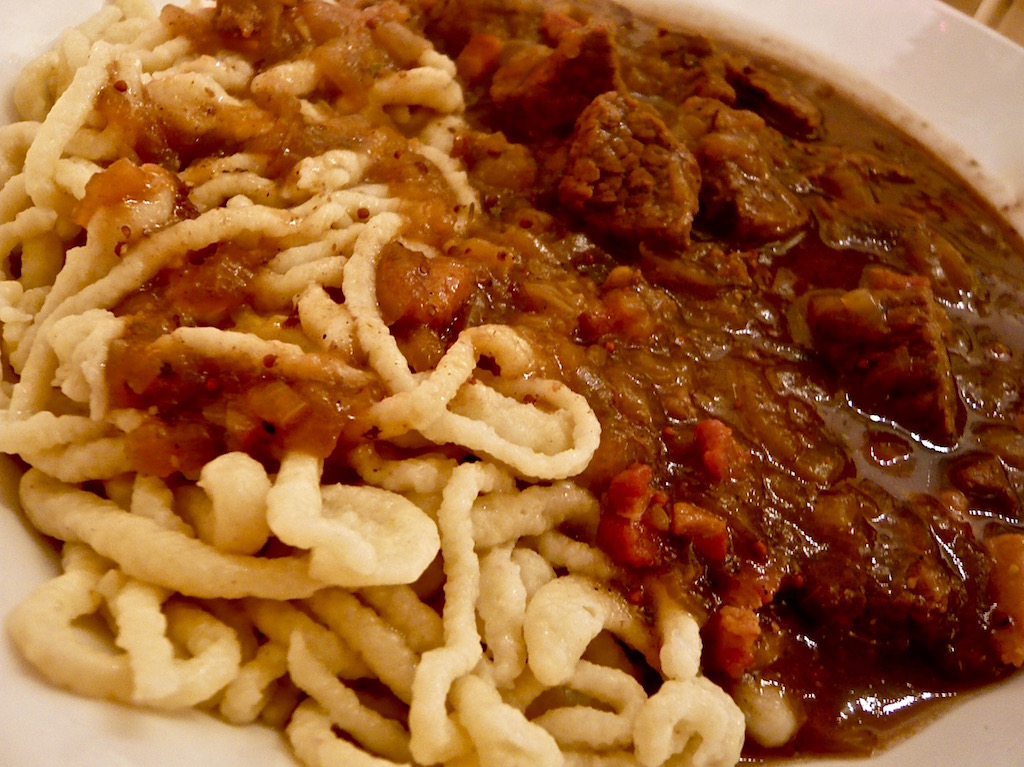Name: Jessica Spengler
Class Year: 1995
Country of Residence: UK
Why is this recipe great? What’s its backstory?
Belgium has beautiful scenery, amazing medieval architecture and fabulous food. Belgian waffles, chocolates and fries are the obvious examples, but my favorite Belgian recipe features one of Belgium’s other great gifts to the culinary world: beer.
Carbonnade à la flamande (also known as stoverij or stoofvlees) is Flemish beef stew in which beef and onions are simmered in Belgian ale until the meat is tender, the onions are jammy and the ale has cooked down into a rich, dark gravy. It has a warmly spiced and slightly sweet-and-sour note traditionally achieved by spreading mustard on a piece of gingerbread and cooking it in the stew—but brown sugar, allspice and a dollop of mustard at the end work just as well. The key to this stew lies in taking a few good ingredients and treating them well to create something much greater than the sum of its parts. It’s a deeply satisfying meal on a cold night.
Carbonnade à la flamande
Serves 2 . Takes approx. 3 hours from start to finish (mostly unattended).
Ingredients:
- 500g cubed stewing or braising beef
- olive or vegetable oil
- 2 slices smoked bacon, chopped
- 3 or 4 medium onions, sliced
- 1/2 tablespoon brown sugar
- 1/2 tablespoon flour
- 1 bottle Belgian ale (Chimay Blue or another rich copper ale)
- 500 mL strong beef broth/stock (a stock cube is fine!)
- 1-2 dried bay leaves
- pinch of thyme (fresh or dried)
- pinch of allspice (optional)
- salt and pepper
- mustard (wholegrain or Dijon works well)
- chopped parsley
Instructions:
You can make carbonnade either entirely on the stovetop, or you can start it on the stove and finish it in the oven. If you’re going to use the oven, preheat it to 175C/350F.
Season the beef generously with salt and pepper and brown it on all sides in a splash of oil over medium heat in a heavy-bottomed pot or casserole. When the meat is browned, take it out of the pot and set it aside, then deglaze the pot by adding a splash of beef broth and scraping up any browned bits with a wooden spoon. Add the broth and bits to the beef, then drop the bacon into the pot and fry it over medium heat until it’s brown. Remove the bacon with a slotted spoon and set it aside with the beef.
Put the onions in the pot and fry them gently in the bacon fat (with a tiny bit of additional oil if needed) until they start to turn soft and golden, which will take a good 15 minutes. After the onions have been cooking for a few minutes, sprinkle over the brown sugar, which will help them caramelize slightly. Once the onions are softened, sprinkle the flour over them and stir it in. Then return the beef, bacon and any accumulated juices to the onions in the pot.
Now comes the fun bit: turn up the heat slightly and pour in the bottle of ale. It will go all fizzy for a few seconds, but then it will calm down. Add enough beef broth to cover the meat and onions, along with the bay leaf, thyme, allspice if you’re using it, and some salt and pepper. Bring this to a boil, then cover and place in the oven. Let it cook for about 2 hours, stirring occasionally, until the meat is tender (if you’re cooking the carbonnade on the stovetop, simply simmer it over low heat for 2 hours; you’ll have to stir it slightly more often to prevent it from burning to the bottom of the pot).
To finish the carbonnade, stir in a handful of chopped parsley and a tablespoon or two of mustard if you’d like. Carbonnade is often served with potatoes or buttered noodles, though a nice crusty bread works well too (or the German Spätzle you can see in the picture!). And a salad of chicory or endive dressed with a mustard vinaigrette makes for a sprightly accompaniment to balance out the dark, rich stew.

Source:
My own version of a traditional recipe – also posted on my food blog: https://principiagastronomica.com/post/21